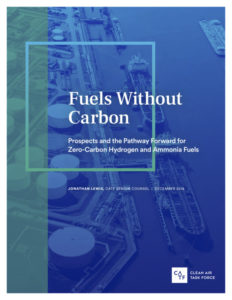Fuels Without Carbon: Prospects and the Pathway Forward for Zero-Carbon Hydrogen and Ammonia Fuels
By Jonathan Lewis on February 21, 2019
A guest editorial by Jonathan Lewis, Senior Counsel at the Clean Air Task Force. Originally published in December 2018, reproduced with permission.
In April 2018, member countries of the International Maritime Organization (IMO) announced an “initial strategy” for cutting the shipping sector’s greenhouse gas emissions in half by 2050. If the worst consequences of climate change are to be avoided, major industries like international shipping will need to do more than cut their emissions by 50% — but the IMO’s mid-century target was nevertheless hailed for its ambition
A mere eight months later, Maersk — the world’s largest container shipping company — announced that it would completely eliminate its GHG emissions by 2050; the company acknowledged that its commitment implies it “will have to abandon fossil fuels.” What prompted Maersk to embrace a corporate GHG reduction goal that’s at least twice as ambitious as the IMO target? Billion-dollar companies rarely commit themselves publicly to goals they think are unobtainable, so it’s reasonable to assume that Maersk sees a pathway to zero emissions.
One pathway to emissions-free shipping that’s under development involves two common chemicals that hold significant promise as zero-carbon fuels: hydrogen (H2) and ammonia (NH3). Both hydrogen and ammonia can be made in enormous, energy market-relevant volumes from processes that emit zero CO2 to the atmosphere, and both can be converted into carbon-free energy using fuel cells, turbines, internal combustion engines, and even repurposed coal boilers.
Hydrogen and ammonia’s potential as zero-carbon fuels is gaining attention, especially in the shipping sector. A cluster of recent reports on reducing the shipping sector’s GHG emissions (e.g. here and here) have identified fuel-switching from heavy fuel oil to ammonia as one of the most compelling options for limiting the sector’s contribution to global warming. Operationally, MAN Energy Solutions is developing ammonia-fueled heavy-duty marine engines, while C-Job, a nautical design firm, is engineering “sustainable and future-proof” ammonia-powered vessels.

Progress in the development of these fuels is changing the way people think about decarbonization — and not just in the shipping sector. A new report from CATF, Fuels Without Carbon: Prospects and the Pathway Forward for Zero-Carbon Hydrogen and Ammonia Fuels, explores how a massive scale-up in the production and use of zero-carbon hydrogen and ammonia might help decarbonize segments of the power sector, the industrial sector, and the transportation sector (both marine and ground). Fuels Without Carbon looks at how the availability of zero-carbon hydrogen and ammonia fuels could help address several vexing climate-energy challenges, and it examines the steps that need to be taken to fully understand and address the safety and environmental risks associated with the two chemicals. Fuels Without Carbon also identifies several public and private sectors initiatives — including a few being pursued by CATF — for analyzing the opportunities and challenges associated with hydrogen and ammonia fuel, educating stakeholders about the potential benefits and risks, designing and advocating for appropriately supportive policies, and engaging with key power and mobility companies.
Interested? Read more here.
A guest editorial by Jonathan Lewis, Senior Counsel at the Clean Air Task Force. Originally published in December 2018, reproduced with permission.